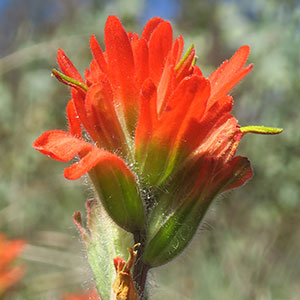Castilleja brevilobata
Castilleja ornata
short-lobed paintbrush
glowing Indian paintbrush, ornate paintbrush
solitary or few, erect or ascending, unbranched, sometimes branched, hairs spreading, short, medium, and long, soft, short and medium ones short stipitate-glandular.
solitary or few to several, erect or ascending, often branched low on stem, unbranched distally, hairs appressed or retrorse, medium length, soft, eglandular, mixed with shorter stipitate-glandular ones.
green or ± yellow, lanceolate, elliptic, or oblong to narrowly ovate, 1–2(–2.5) cm, not fleshy, margins plane or wavy, involute, (0–)3–5(–7)-lobed, apex rounded to acute;
lobes ascending to erect, linear to lanceolate, apex rounded to acute.
green or purple-tinged, proximal forming a rosette, linear-lanceolate to oblong or oblanceolate, 2–4 cm, not fleshy, clasping, margins wavy, sometimes plane, involute, 0-lobed, apex acuminate, acute, or obtuse.
3–20 × 2–3.5 cm;
bracts proximally greenish to dull brown, distally red, orange-red, or scarlet, sometimes orange or yellow, broadly lanceolate or oblong, (0–)3–5-lobed;
lobes ascending, broadly to narrowly lanceolate, short, arising above mid length, apex acute, obtuse, or rounded.
3–24 × 1.5–3 cm;
bracts proximally green, distally white, sometimes very pale yellow, often aging dull pink or dull red-purple, spatulate, 0-lobed, sometimes seeming lobed due to wavy margins, apex obtuse to rounded.
straight, 15–24(–26) mm;
tube 12–16 mm;
beak exserted, abaxial lip equal to calyx;
beak adaxially green or ± yellow-green, 7–10 mm, puberulent, stipitate-glandular;
abaxial lip deep green, reduced, rounded, 1–2 mm, 10–25% as long as beak;
teeth incurved to erect, light green, 0.5–1 mm.
slightly curved, 22–24 mm;
tube 10–13 mm;
beak exserted, adaxially green, 5–10 mm;
abaxial lip pale greenish, reduced, pouches 3, 0.5–1.5 mm, 5–10% as long as beak;
teeth slightly incurved, reduced, pale greenish to white, 0.3–0.7 mm.
green or whitish with green veins, lobes colored as bract lobes or paler, 14–30 mm;
abaxial and adaxial clefts 5.5–8.5 mm, 30–40% of calyx length, deeper than laterals, lateral 1.5–4 mm, 20–25% of calyx length;
lobes oblong to narrowly triangular, apex obtuse to rounded.
green throughout or distal margin white aging pink, 15–17 mm;
abaxial and adaxial clefts 6–14 mm, 35–45% of calyx length, deeper than laterals, lateral 0(–0.7) mm, 0(–5)% of calyx length;
lobes short-triangular, abaxial segments longer than adaxials, apex acute to obtuse or rounded.
= 24.
= 24.
Castilleja brevilobata
Castilleja ornata
Castilleja brevilobata is endemic to dry serpentine openings in the Siskiyou Mountains of southwestern Oregon and adjacent California. Although sometimes treated as part of C. applegatei or C. hispida, its morphology does not suggest a close connection with either. This species occasionally hybridizes with C. pruinosa in Del Norte County, California.
(Discussion copyrighted by Flora of North America; reprinted with permission.)
Castilleja ornata is known from Chihuahua and northern Durango, Mexico, but much of its seasonally moist grassland habitat is now altered by grazing or agriculture, and there are no recent sightings of the species south of the United States border. There is a recently discovered population in southwestern New Mexico, in the southern Animas Valley of Hidalgo County. While very rare, C. ornata lacks federal protection. The small Animas Valley population is the last known extant occurrence, and this population was reduced to two individuals in a census conducted in 2017 (D. Roth, pers. comm.). The species appears to be critically endangered globally and in need of conservation management.
The inflorescences of Castilleja ornata have pale greenish bracts with white apices when young, but the apices often become pale pink to dull reddish with age. Its pubescence, wavy-margined leaves, and unusual bract color also distinguish C. ornata. Castilleja exserta and C. minor are the only other annual paintbrushes in New Mexico and differ from C. ornata by the color of their floral bract apices, which are usually pink to red-purple in C. exserta and bright red in C. minor.
(Discussion copyrighted by Flora of North America; reprinted with permission.)


